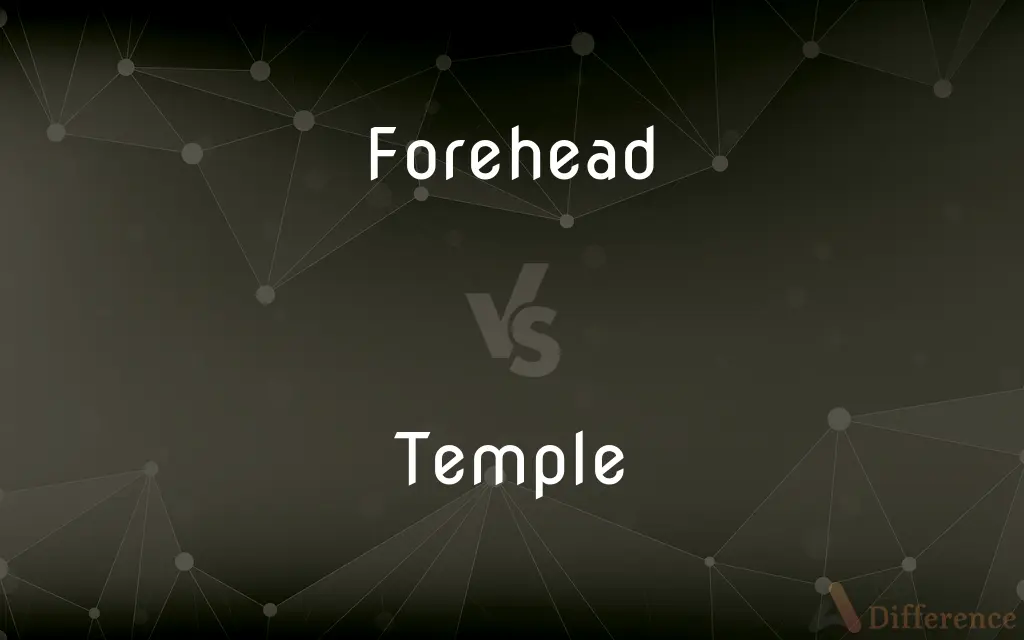Forehead vs. Temple — What's the Difference?
Edited by Tayyaba Rehman — By Maham Liaqat — Updated on May 8, 2024
The forehead is the broad area of the face between the eyebrows and the hairline, whereas the temple refers to the flat region on each side of the head, behind the eyes and between the forehead and ear.

Difference Between Forehead and Temple
Table of Contents
ADVERTISEMENT
Key Differences
The forehead is a prominent facial region located above the eyebrows and extending to the hairline. On the other hand, the temple is situated on either side of the head, slightly above and to the side of the eyes, bordered by the forehead and ear.
The forehead is typically rounded or sloped and covered by skin, often with visible lines or wrinkles due to facial expressions. Meanwhile, the temples are flat regions that include the temporal bone of the skull, often felt through the thin skin.
The forehead is central to facial expressions, contributing to emotions like surprise and frowning. In contrast, the temples aren't directly involved in expression but play a role in head shape and accommodate blood vessels and nerves.
A broad or high forehead is sometimes considered a sign of intelligence or attractiveness in different cultures. However, temples can show signs of stress and fatigue when the blood vessels in that area pulsate or ache.
The forehead is often exposed in hairstyles and frames the face, while the temples are usually covered by hair, serving as a border between facial features and the rest of the skull.
ADVERTISEMENT
Comparison Chart
Location
Between eyebrows and hairline
Behind the eyes, above the ear
Shape
Rounded or sloped
Flat, slightly concave
Bone Structure
Frontal bone
Temporal bone
Function
Facial expressions, framing the face
Contains blood vessels, nerves, skull shape
Cultural Impact
Symbol of intelligence or beauty
Linked to stress and fatigue
Compare with Definitions
Forehead
Part of the frontal bone structure.
The blow struck her directly on the forehead.
Temple
Bordered by the ear and forehead.
The pain radiated from his temple to his jaw.
Forehead
The area between the eyebrows and the hairline.
He wiped the sweat off his forehead after exercising.
Temple
Helps define the shape of the skull and head.
Her temples ached from the strain of staring at the screen.
Forehead
Prominent facial region that helps in expressing emotions.
Her forehead creased in confusion at the question.
Temple
Contains the temporal bone and underlying structures.
He felt a sharp pain in his left temple after the impact.
Forehead
Covered by the skin, often prone to wrinkles.
His forehead lines deepened with age.
Temple
Houses important nerves and blood vessels.
The temple is sensitive to pressure due to the nerves running through it.
Forehead
Frames the upper part of the face and eyes.
Her bangs fell over her forehead, giving her a youthful look.
Temple
The flat region on each side of the head, behind the eyes.
The doctor checked the pulse in her temple.
Forehead
In human anatomy, the forehead is an area of the head bounded by three features, two of the skull and one of the scalp. The top of the forehead is marked by the hairline, the edge of the area where hair on the scalp grows.
Temple
A temple (from the Latin templum) is a building reserved for spiritual rituals and activities such as prayer and sacrifice. Religions which erect temples include Hinduism, Buddhism, Sikhism, Jainism, Christianity (whose temples are typically called churches), Islam (whose temples are called mosques), Judaism (whose temples are called synagogues), and ancient religions such as the Ancient Egyptian religion.
Forehead
The part of the face above the eyebrows.
Temple
A building devoted to the worship of a god or gods.
Forehead
The part of the face between the eyebrows, the normal hairline, and the temples.
Temple
A group of buildings in Fleet Street, London, which stand on land formerly occupied by the headquarters of the Knights Templar. Located there are the Inner and Outer Temple, two of the Inns of Court.
Forehead
The front part of something.
Temple
The flat part of either side of the head between the forehead and the ear
A man with curly hair greying at the temples
Forehead
(countable) The part of the face above the eyebrows and below the hairline.
Temple
A device in a loom for keeping the cloth stretched.
Forehead
(uncountable) confidence; audacity; impudence.
Temple
A building dedicated to religious ceremonies or worship.
Forehead
The upper part of a mobile phone, above the screen.
Temple
Temple Either of two successive buildings in ancient Jerusalem serving as the primary center for Jewish worship.
Forehead
The front of that part of the head which incloses the brain; that part of the face above the eyes; the brow.
Temple
(Judaism) A synagogue, especially of a Reform congregation.
Forehead
The aspect or countenance; assurance.
To look with forehead bold and big enoughUpon the power and puissance of the king.
Temple
Mormon Church A building in which the sacred ordinances are administered.
Forehead
The front or fore part of anything.
Flames in the forehead of the morning sky.
So rich advantage of a promised gloryAs smiles upon the forehead of this action.
Temple
Something regarded as having within it a divine presence.
Forehead
The part of the face above the eyes
Temple
A building used for meetings by any of several fraternal orders, such as the Freemasons.
Forehead
The large cranial bone forming the front part of the cranium: the forehead and the upper part of the orbits
Temple
A building reserved for a highly valued function
The library, a temple of learning.
Temple
Temple Either of two groups of buildings in London, the Inner Temple and the Middle Temple, that house two of the four Inns of Court and that occupy the site of a complex used by the medieval Knights Templars.
Temple
The flat region on either side of the forehead.
Temple
Either of the sidepieces of a frame for eyeglasses that extends along the temple and over the ear.
Temple
A device in a loom that keeps the cloth stretched to the correct width during weaving.
Temple
A house of worship, especially:
Temple
A house of worship dedicated to a polytheistic faith.
The temple of Zeus was very large.
Temple
(Judaism) synagogue, especially a non-Orthodox synagogue.
How often do you go to temple?
Temple
(Mormonism) As opposed to an LDS meetinghouse, a church closed to non-Mormons and necessary for particular rituals.
Temple
(in Japan) A Buddhist monastery, as opposed to a Shinto shrine.
Temple
A meeting house of the Oddfellows fraternity; its members.
Temple
(figurative) Any place regarded as holding a religious presence.
Temple
(figurative) Any place seen as an important centre for some activity.
A temple of commerce;
A temple of drinking and dining
Temple
(figurative) Anything regarded as important or minutely cared for.
My body is my temple.
Temple
(figurative) A gesture wherein the forefingers are outstretched and touch pad to pad while the other fingers are clasped together.
Temple
(anatomy) The slightly flatter region, on either side of the human head, behind of the eye and forehead, above the zygomatic arch, and forward of the ear.
Temple
(ophthalmology) Either of the sidepieces on a set of spectacles, extending backwards from the hinge toward the ears and, usually, turning down around them.
Temple
(weaving) A contrivance used in a loom for keeping the web stretched transversely.
Temple
(transitive) To build a temple for; to appropriate a temple to; to temple a god
Temple
A contrivence used in a loom for keeping the web stretched transversely.
Temple
The space, on either side of the head, back of the eye and forehead, above the zygomatic arch and in front of the ear.
Temple
One of the side bars of a pair of spectacles, jointed to the bows, and passing one on either side of the head to hold the spectacles in place.
Temple
A place or edifice dedicated to the worship of some deity; as, the temple of Jupiter at Athens, or of Juggernaut in India.
Temple
The edifice erected at Jerusalem for the worship of Jehovah.
Jesus walked in the temple in Solomon's porch.
Temple
Hence, among Christians, an edifice erected as a place of public worship; a church.
Can he whose life is a perpetual insult to the authority of God enter with any pleasure a temple consecrated to devotion and sanctified by prayer?
Temple
Fig.: Any place in which the divine presence specially resides.
Know ye not that ye are the temple of God, and that the spirit of God dwelleth in you?
The groves were God's first temples.
Temple
A building dedicated to the administration of ordinances.
Temple
A local organization of Odd Fellows.
Temple
To build a temple for; to appropriate a temple to; as, to temple a god.
Temple
Place of worship consisting of an edifice for the worship of a deity
Temple
The flat area on either side of the forehead;
The veins in his temple throbbed
Temple
An edifice devoted to special or exalted purposes
Temple
(Judaism) the place of worship for a Jewish congregation
Common Curiosities
Where is the forehead located?
The forehead is above the eyebrows and below the hairline.
Are temples prone to stress-related pain?
Yes, the temples can ache or throb due to stress, migraines, or tension headaches.
Can the forehead reveal emotions?
Yes, the forehead often displays emotions through expressions like frowning or surprise.
What part of the skull supports the temples?
The temporal bones of the skull support the temples.
Can the forehead and temples be massaged?
Yes, massaging the forehead and temples can help relieve tension or headaches.
Is the forehead made up of bone or muscle?
The forehead is supported by the frontal bone and covered by muscles and skin.
Why do the forehead and temples bruise easily?
They are both thin-skinned areas and thus more prone to bruising and visible discoloration.
Why do the temples sometimes pulse?
Pulsing in the temples may be due to increased blood flow, often linked to stress or exertion.
Is the forehead prone to injury?
Yes, due to its prominent location, the forehead can be prone to bruising and cuts.
What nerves are found in the temple?
The temple contains the temporal nerves, which are sensitive and can cause headaches.
How do the forehead and temples relate to hairstyles?
Hairstyles can frame or cover the forehead and temples, influencing facial aesthetics.
Do temples contain glands?
Yes, temples contain sebaceous glands that can contribute to acne or oily skin.
Is the forehead an important facial feature?
Yes, it frames the face and contributes to overall facial symmetry and appearance.
Are temples sensitive to temperature changes?
Yes, because of the nerves and blood vessels, temples can be sensitive to heat or cold.
Can stress affect the forehead or temples?
Yes, stress can cause tension headaches or muscle contractions affecting these areas.
Share Your Discovery

Previous Comparison
Baklava vs. Kataifi
Next Comparison
Platoon vs. SquadronAuthor Spotlight
Written by
Maham LiaqatEdited by
Tayyaba RehmanTayyaba Rehman is a distinguished writer, currently serving as a primary contributor to askdifference.com. As a researcher in semantics and etymology, Tayyaba's passion for the complexity of languages and their distinctions has found a perfect home on the platform. Tayyaba delves into the intricacies of language, distinguishing between commonly confused words and phrases, thereby providing clarity for readers worldwide.
















































